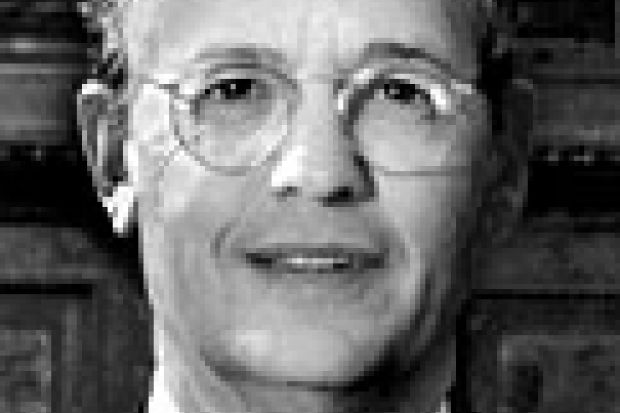Princeton University revives its Scottish connection on June 22 and simultaneously salutes the end of a remarkable chapter in American education.
After almost 14 years as Princeton president, Harold Shapiro is to unveil a monument in Paisley to John Witherspoon, the local minister whose distinction as perhaps Princeton's greatest leader is undiminished after two-and-a-half centuries.
Professor Shapiro's climb to the top of the academic ladder was not dissimilar to that of his antecedent.
Reverend Witherspoon was a religious and political dissident, who departed his native land following Culloden and took a central part in the American revolution. He was friends with George Washington, an early donor in support of the college's flagging finances.
Professor Shapiro also has immigrant roots. Of Jewish stock, his family moved to Canada, but encountered entrenched anti-Semitism in Montreal in the early 1930s when the children were excluded from the district's single school and forced to go to school elsewhere.
Professor Shapiro went on to study economics at McGill University, where Jewish applicants had to achieve entrance grades 10 per cent better than other applicants. Even then, Jewish students were limited to 10 per cent of the first year's intake.
Like Reverend Witherspoon, he found abundant opportunities in the United States. His appointment as Princeton president was groundbreaking as the campus was noted for its exclusionary attitudes towards Jews and women.
Professor Shapiro was also successful in raising money - Princeton's endowment increased five-fold during his tenure.
But this talent was already evident during his presidency of Michigan State University at Ann Arbor.
His special legacy at Princeton is the introduction of fee support formulae that give across-the-board (needs-blind) assistance for any student, international or domestic, unable to bear the cost of a Princeton education but qualifying academically.
Fund-raising is a controversially time-consuming task for presidents in the US today.
Professor Shapiro said: "Mobilising resources is difficult for a university president in this country. My way was no more than 20-25 per cent of my schedule. I do what I can in that time and devote the rest to other things."
These include regular contact with students. He had an open-door policy on Mondays and gave weekly lectures in economics, in which he gained a doctorate at Princeton.
Professor Shapiro's public service to his religious community is also reminiscent of Reverend Witherspoon. During his tenure at Michigan, both as president and professor of economics, the state legislature was in the habit of inviting him to give classes in practical economics, which achieved a quasi-legendary reputation and raised the university's profile.
Professor Shapiro has also put Princeton in the national limelight by serving under successive presidents, most recently as chairman of Bill Clinton's national advisory committee for bioethics.
After the summer, Professor Shapiro will return to the Woodrow Wilson school of public and international affairs, where he will exchange economics for bioethics.
He also attracted worldwide attention after his recent appointment of Peter Singer, the celebrated bioethicist, to Princeton's faculty.
Robert George, professor of jurisprudence at Princeton, said the Paisley unveiling had nothing to do with religion, Christian or Jewish.
Professor George argued that Reverend Witherspoon "wouldn't recognise Princeton (now) for its thinned-out new-age spiritualities and vague references to ideals that are beyond the material, but without any substance or rootedness in Christianity, in the Hebraic tradition, even in the classical tradition."
Professor George speculated on what Witherspoon might have to say to Professor Shapiro. "He might observe a sharpening of mental skills, but not reaching anything recognisable as an understanding of human meaning, value and significance."
- Shirley M. Caldwell Tilghman takes over as Princeton's 19th and first woman president today. She joined Princeton in 1986 as Howard A. Prior professor of life sciences and in 1999 was a founding director of the university's Lewis-Siegler Institute for Integrative Genomics, an extension of her key role nationally in mapping the human genome.
Professor Caldwell, a Canadian, was also a founder of the National Advisory Council of the Human Genome Project Initiative for the National Institutes of Health. Her academic work has focused on mammalian genetics, especially the role of genes in embryo development.
She is renowned for promoting the cause of women in science. Trends in the Careers of Life Sciences, a report published in 1998 by a committee she chaired for the National Research Council, pushed her into the spotlight. Between 1993 and 2000, she chaired Princeton's council on science and technology and received the President's Award (1996) for Distinguished Teaching.
She was responsible for initiating Princeton's post-doctoral teaching fellowship, which spans all science and engineering disciplines and brings postdoctoral students to the campus each year for research and teaching.
She leads an alumni course on the human genome.
Register to continue
Why register?
- Registration is free and only takes a moment
- Once registered, you can read 3 articles a month
- Sign up for our newsletter
Subscribe
Or subscribe for unlimited access to:
- Unlimited access to news, views, insights & reviews
- Digital editions
- Digital access to THE’s university and college rankings analysis
Already registered or a current subscriber?
